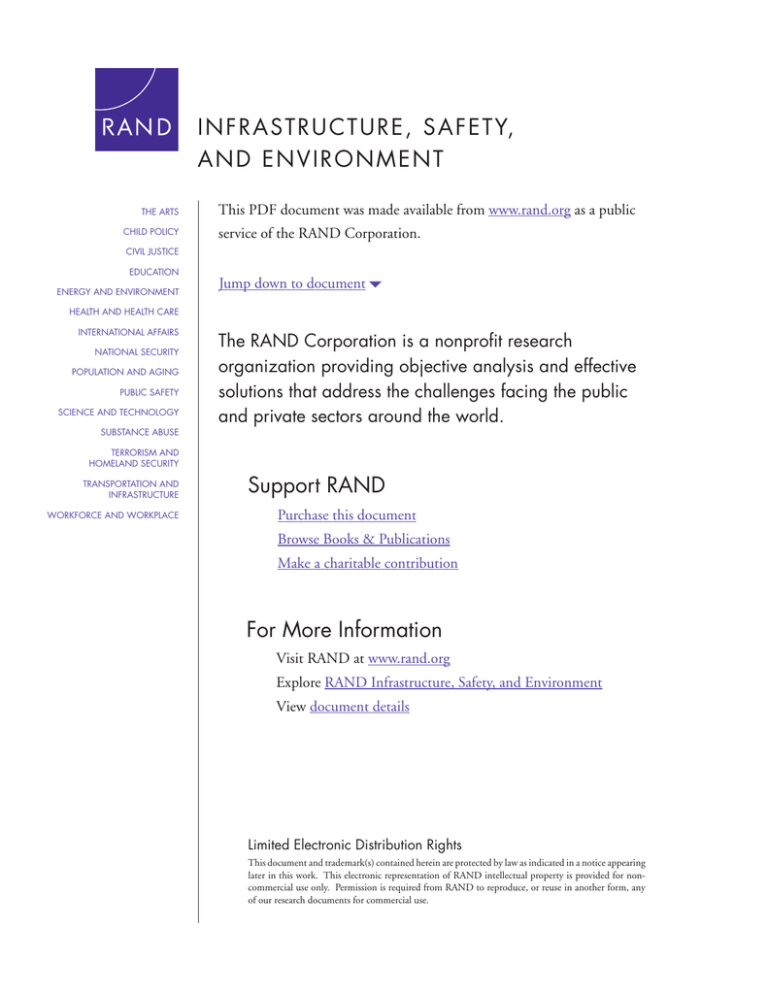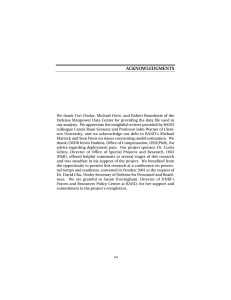
INFRASTRUCTURE, SAFETY,
AND ENVIRONMENT
THE ARTS
CHILD POLICY
This PDF document was made available from www.rand.org as a public
service of the RAND Corporation.
CIVIL JUSTICE
EDUCATION
ENERGY AND ENVIRONMENT
Jump down to document6
HEALTH AND HEALTH CARE
INTERNATIONAL AFFAIRS
NATIONAL SECURITY
POPULATION AND AGING
PUBLIC SAFETY
SCIENCE AND TECHNOLOGY
SUBSTANCE ABUSE
The RAND Corporation is a nonprofit research
organization providing objective analysis and effective
solutions that address the challenges facing the public
and private sectors around the world.
TERRORISM AND
HOMELAND SECURITY
TRANSPORTATION AND
INFRASTRUCTURE
WORKFORCE AND WORKPLACE
Support RAND
Purchase this document
Browse Books & Publications
Make a charitable contribution
For More Information
Visit RAND at www.rand.org
Explore RAND Infrastructure, Safety, and Environment
View document details
Limited Electronic Distribution Rights
This document and trademark(s) contained herein are protected by law as indicated in a notice appearing
later in this work. This electronic representation of RAND intellectual property is provided for noncommercial use only. Permission is required from RAND to reproduce, or reuse in another form, any
of our research documents for commercial use.
This product is part of the RAND Corporation occasional paper series. RAND
occasional papers may include an informed perspective on a timely policy issue, a
discussion of new research methodologies, essays, a paper presented at a conference, a
conference summary, or a summary of work in progress. All RAND occasional papers
undergo rigorous peer review to ensure that they meet high standards for research
quality and objectivity.
Revisiting US-VISIT
U.S. Immigration Processes,
Concerns, and Consequences
David S. Ortiz, Shari Lawrence Pfleeger,
Aruna Balakrishnan, Merril Miceli
Approved for public release; distribution unlimited
The research described in this report results from the RAND Corporation’s continuing
program of self-initiated research. Support for such research is provided, in part, by
donors and by the independent research development provisions of RAND’s contracts
for the operation of its U.S. Department of Defense federally funded research and
development centers. This research was conducted within RAND Infrastructure, Safety,
and Environment (ISE), a unit of the RAND Corporation.
Library of Congress Cataloging-in-Publication Data
Revisiting US-VISIT : U.S. immigration processes, concerns, and consequences / David S. Ortiz ... [et al.].
p. cm. — (Occassional paper ; OP-140)
Includes bibliographical references.
ISBN 0-8330-3912-1 (pbk. : alk. paper)
1. United States—Emigration and immigration—Government policy. 2. France—Emigration and
immigration—Government policy. 3. Visas—Government policy—United States. 4. Visas—Government
policy—France. 5. Terrorism—United States—Prevention. 6. Terrorism—France—Prevention. I. Ortiz,
David (David Santana) II. Series: Occasional paper (Rand Corporation) ; OP-140.
JV6483.R472 2006
325.73—dc22
2006001872
The RAND Corporation is a nonprofit research organization providing objective analysis
and effective solutions that address the challenges facing the public and private sectors
around the world. RAND’s publications do not necessarily reflect the opinions of its
research clients and sponsors.
R® is a registered trademark.
© Copyright 2006 RAND Corporation
All rights reserved. No part of this book may be reproduced in any form by any electronic or
mechanical means (including photocopying, recording, or information storage and retrieval)
without permission in writing from RAND.
Published 2006 by the RAND Corporation
1776 Main Street, P.O. Box 2138, Santa Monica, CA 90407-2138
1200 South Hayes Street, Arlington, VA 22202-5050
4570 Fifth Avenue, Suite 600, Pittsburgh, PA 15213-2612
RAND URL: http://www.rand.org/
To order RAND documents or to obtain additional information, contact
Distribution Services: Telephone: (310) 451-7002;
Fax: (310) 451-6915; Email: order@rand.org
Summary
In January 2004, the U.S. Department of Homeland Security (DHS) inaugurated a new
system for the tracking of foreign visitors at ports of entry to the United States: the United
States Visitor and Immigrant Status Indicator Technology (US-VISIT) program. The rollout
occurred at 115 air and 14 sea ports of entry. Visitors with nonimmigrant visas found that to
gain entry to the United States, they needed to submit to a photograph and a fingerprint scan.
DHS claims that the photograph and fingerprint add only a few seconds to the inspection time
for each visitor but give DHS the opportunity to verify identity and to compare the applicant
against text-based and biometric watch lists maintained by law enforcement agencies. Furthermore, the U.S. Department of State’s new visa procedures require all visitors needing a visa to
apply in person for the travel document, at which time a digital photograph and fingerprints
are collected and incorporated into the US-VISIT system. The US-VISIT requirements were
extended to visitors from the 27 Visa Waiver Program (VWP) countries in October 2004. To
remain eligible to enter the United States under the VWP, travelers from these countries must
possess a passport containing a digital photograph if that passport was issued after October 26,
2005. The system has also been implemented at the 50 busiest land ports of entry. Exit kiosks
are being installed at ports so that visitors can record their exit from the United States.
Fundamentally, US-VISIT is an electronic system for verifying a traveler’s identity and
ensuring that the traveler is not sought by a law enforcement agency. Congress mandated that
the U.S. Immigration and Naturalization Service develop a system for monitoring visitor access
to the United States in 1996. Congress subsequently deferred the program’s implementation
from October 15, 1998, to March 30, 2001, fearing increased congestion at U.S. border crossings (U.S. Department of Homeland Security, 2005). However, the attacks of September 11,
2001, provided a motivation for development and implementation. Now, DHS entities U.S.
Customs and Border Protection (CBP), U.S. Citizenship and Immigration Services (USCIS),
and U.S. Immigration and Customs Enforcement (ICE) maintain and operate the US-VISIT
system. The US-VISIT system consists of user terminals, databases, and communication links
that allow a CBP inspector to collect a visitor’s biographic and biometric information and
compare it against criminal watch lists, lists of foreign students, and accepted and rejected visa
holders. US-VISIT is being implemented in four increments, with the first initiated in January
2004, and the final configuration of the system available near the end of the decade. Proper
operation requires the coordination of the component databases, each of which is monitored
xi
xii
Revisiting US-VISIT: U.S. Immigration Processes, Concerns, and Consequences
by a different government agency, and the maintenance of the communication links among
the subsystems. Because US-VISIT data are personal and sensitive, care is required to maintain
personal privacy and security.
In the mid-1980s, when France was the victim of a series of terrorist attacks, it tightened
its immigration and visitor controls by means of the “Pasqua Laws.” Visa requirements were
imposed on all visitors from countries other than those of the then–European Community,
and Liechtenstein, Monaco, Andorra, and Switzerland. The European Community convened
meetings on appropriate responses to terrorism, including increased airport security. Affected
nations, including the United States, reacted negatively to the new requirements, processes, and
procedures for obtaining a visa. Within France, there were complaints of program mismanagement and warnings of deleterious effects on travel and trade. There are many parallels between
France’s actions in 1986 and U.S. actions today in response to terrorist attacks. Imposition of
a visa requirement in France seems to have had no long-term negative economic impact on
trade and tourism; the visa requirement led to an initial drop in immigration that persisted
for several years. The international community seems to have understood that a trade-off can
be made between free access and national security. Similar drops may be less desirable in the
United States, particularly for seasonal workers and students. The effects of the French visa
requirements were felt in the context of a larger, intentionally restrictive immigration policy;
US-VISIT’s effects must be viewed in the same larger context, with reasoned consideration
of what the United States would like to accomplish through regulation of immigration and
border controls.
These lessons, coupled with a detailed view of the workings of US-VISIT, enable us
to identify key policy questions that should be discussed as the system is implemented, and
expanded throughout the decade. These questions include the following:
• How can database and communication links be made reliable and available?
• How can the user interface be designed to speed processing and minimize human error?
• How can the design of US-VISIT ensure privacy and incorporate fair information practices, including limitations on the government’s ability to collect and disclose data inappropriately, guarantees of security, and opportunities for stakeholders—including the foreign visitors themselves—to petition for redress and correction of the data?
• How can US-VISIT guarantee proper coordination among the disparate government
agencies that control data used by US-VISIT to segregate legitimate travelers (such as
students, tourists, and business visitors) from criminals?
• How can US-VISIT and related processes, such as Department of State consular services,
be monitored so that the United States can minimize their effects on legitimate travel,
trade, and tourism?
These policy issues in particular, and our analysis in general, suggest several targets of
future inquiry.
1. US-VISIT is a complicated technological and interagency-implemented system that
will affect all visitors to the United States. An independent analysis of US-VISIT com-
Summary
xiii
ponents and processes from a systems engineering standpoint would help to set standards for system operation and maintenance to ensure seamless coordination among
databases and systems.
2. US-VISIT collects personal information from foreign travelers. Many countries, in particular those of the European Union, have far more stringent regulations regarding
the collection and use of personal data. An analysis of the extent to which US-VISIT
complies with these laws would aid the United States in promoting the system abroad.
Additionally, cultural considerations regarding the collection of photographs and fingerprints should be addressed.
3. US-VISIT monitors only legal visitors to the United States. It is imperative that DHS
quantify the costs and benefits of US-VISIT in the broader context of overall border
control.
4. Proponents and critics of US-VISIT should be patient in evaluating the system. A lesson
from France’s immigration policy changes is that the initial shock of the policies had
short-term effects, but tourism and trade recovered over time.






